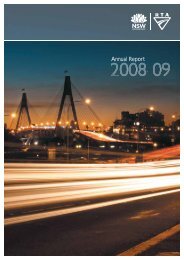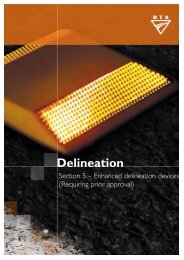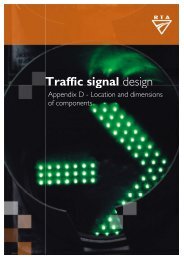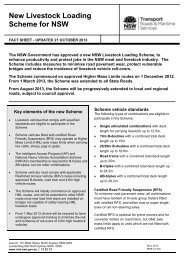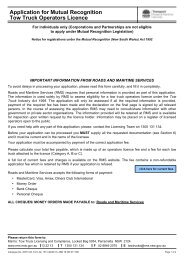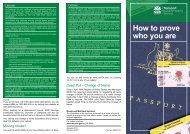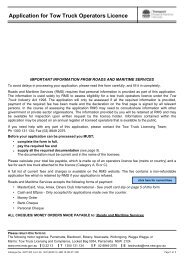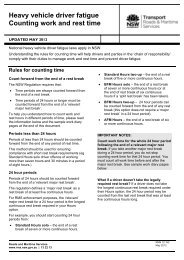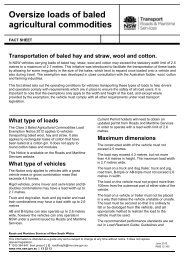Annual Report 2006 (main body) - RTA - NSW Government
Annual Report 2006 (main body) - RTA - NSW Government
Annual Report 2006 (main body) - RTA - NSW Government
You also want an ePaper? Increase the reach of your titles
YUMPU automatically turns print PDFs into web optimized ePapers that Google loves.
WORLD MARKET<br />
The SCATS system continues to be a<br />
proven success with an expanding<br />
international market. SCATS is currently<br />
licensed to over 8,649 intersections in<br />
eight states and territories in Australia,<br />
and a further 15,000 sites in 84 cities<br />
in 21 overseas countries.<br />
and spills, the TMC passes information to the<br />
public through the media, the call centre and<br />
Variable Message Signs (VMS).<br />
The TMC is responsible for ensuring<br />
that traffic systems operate at peak<br />
performance. TMC activities include finetuning<br />
coordinated traffic signal systems and<br />
controlling other traffic operations such as:<br />
Deployment of traffic commanders<br />
to assume primary responsibility for<br />
traffic management around incidents<br />
on major roads in <strong>NSW</strong>.<br />
Deployment of a Traffic Emergency Patrol<br />
Service who routinely patrol major routes<br />
in Sydney and surrounding areas to<br />
identify and assist when incidents occur.<br />
Operation of Variable Speed Limit<br />
signs on all motorways so that speed<br />
limits may be adjusted in response<br />
to prevailing traffic conditions.<br />
Expansion and operation of the<br />
network of 492 VMS across Sydney’s<br />
metropolitan area and selected major<br />
routes across the State.<br />
Expansion and operation of the<br />
closed circuit television network<br />
of 606 cameras that monitor roads<br />
across Sydney and selected major<br />
routes throughout the State.<br />
Operation, management and<br />
<strong>main</strong>tenance of the Sydney Harbour<br />
Bridge lane control system and other<br />
electronic and manual tidal flow systems<br />
throughout the Greater Sydney area.<br />
Development of the Sydney Transport<br />
Evacuation Precinct Plan in conjunction<br />
with other government agencies<br />
to control traffic operations and<br />
pedestrian movements in the Sydney<br />
CBD in the event of a disaster.<br />
Intersection and<br />
corridor improvements<br />
Travel delays in 2005–06 were reduced.<br />
This was achieved by improvements to<br />
intersections and better access to major<br />
roads on corridors and at specific locations.<br />
Routes and locations in need of attention<br />
have been identified through monitoring<br />
congestion and travel times on the network.<br />
Improvements included construction of<br />
traffic signals, roundabouts and intersection<br />
upgrades in the urban Sydney area –<br />
President Avenue and Sylvania Road<br />
Gymea; South Western Region – Olympic<br />
Way and Jennings Road Henty; Snowy<br />
Mountains Highway and Talbingo Road<br />
Talbingo; Southern Region – Princess<br />
Highway and Cranbrook/Hughes Road<br />
intersection Batemans Bay; Hunter Region<br />
– Princess Highway from Hexham Bridge<br />
to Shamrock Street Hexham;The Entrance<br />
Road Wyong; Western Region – Golden<br />
Highway and Yarrandale Road Dubbo;<br />
Percy and Maughan Streets Wellington;<br />
Barriers Highway and Kidman Way Cobar.<br />
Traffic signal coordination<br />
The essential task of coordinating traffic<br />
signals is carried out by the Sydney<br />
Coordinated Adaptive Traffic System<br />
(SCATS). The system responds to traffic<br />
demand in real time and coordinates traffic<br />
signal timings to ensure smooth traffic flows.<br />
SCATS’ capability was considerably<br />
enhanced in August 2005 with the first<br />
deployment of the Traffic Management<br />
Interface System (TMIS). TMIS provides<br />
a user configurable map-based interface<br />
for the traffic management software<br />
applications used in the TMC including<br />
SCATS, Public Transport Information<br />
Processing System, Central Management<br />
Computer System, Traffic Information<br />
<strong>Report</strong>ing Facility and Video Control<br />
System. It displays information from these<br />
applications, such as site status, signal fault<br />
alarms, locations of congestion, CCTV<br />
images and incidents.<br />
The first release of TMIS provides a<br />
foundation for further application interfaces<br />
which will come online as needed.<br />
<strong>Annual</strong> upgrade agreements have now been<br />
established with all <strong>RTA</strong> supported SCATS<br />
users in Australia, New Zealand and<br />
Singapore. These users will have the latest<br />
version of the SCATS software, thus<br />
reducing the demand on <strong>RTA</strong> resources to<br />
support superseded versions of SCATS.The<br />
annual update agreements also provide a<br />
guaranteed annual income stream to offset<br />
SCATS development and support costs.<br />
Electronic toll collection<br />
The <strong>RTA</strong>’s responsibilities for tolling include<br />
the collection of cash and electronic tolls at<br />
the Sydney Harbour Bridge and Tunnel, toll<br />
enforcement services for all <strong>NSW</strong> toll roads,<br />
and electronic tag distribution and customer<br />
account management.<br />
Electronic toll collection and E-only lanes<br />
allow easier passage through toll booths.<br />
There are also environmental benefits<br />
because air and noise pollution is reduced<br />
when vehicles do not have to stop to pay<br />
a toll.<br />
The <strong>RTA</strong> played the leading role in<br />
introducing electronic tolling to <strong>NSW</strong> toll<br />
roads and continues to show a lead in<br />
supporting and <strong>main</strong>taining interoperability<br />
between all toll roads in eastern Australia.<br />
The result has been a rapid expansion in<br />
tag use with the <strong>RTA</strong> alone issuing around<br />
357,000 tags by end of June <strong>2006</strong>.<br />
Toll systems<br />
The <strong>RTA</strong> has implemented a number of new<br />
systems to support the tolling operation.<br />
The systems have been designed to improve<br />
28 POSITIVE ECONOMIC OUTCOMES



